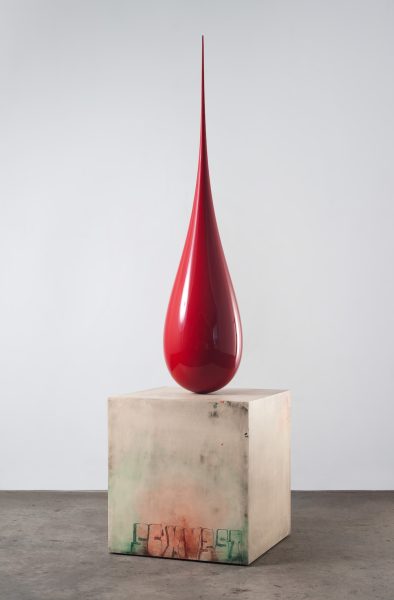
Sterling Ruby, SCXV3ST/BD, 2012. Fiberglass, wood, spray paint, and formica 120 × 34 × 34 inches (304.8 × 86.4 × 86.4 cm). Courtesy Sterling Ruby Studio, Los Angeles. Photo by Robert Wedemeyer. © Sterling Ruby
Museum admission tickets are now available through May 23. Reserve now

Sterling Ruby, SCXV3ST/BD, 2012. Fiberglass, wood, spray paint, and formica 120 × 34 × 34 inches (304.8 × 86.4 × 86.4 cm). Courtesy Sterling Ruby Studio, Los Angeles. Photo by Robert Wedemeyer. © Sterling Ruby
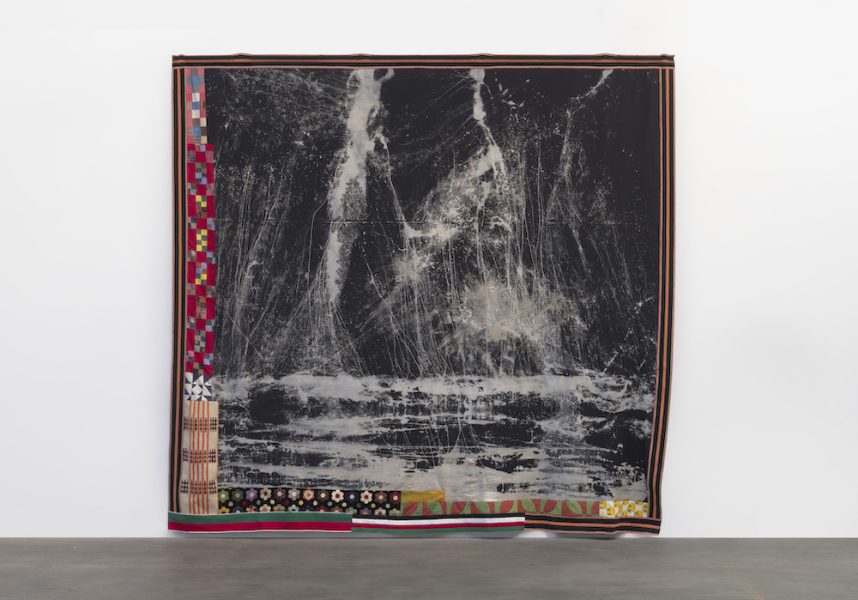
Sterling Ruby, FLAG/QUILT (6625), 2018. Bleached denim, treated fabric, and elastic 164 × 170 inches (416.6 × 431.8 cm). Courtesy Sterling Ruby Studio, Los Angeles. Photo by Robert Wedemeyer. © Sterling Ruby
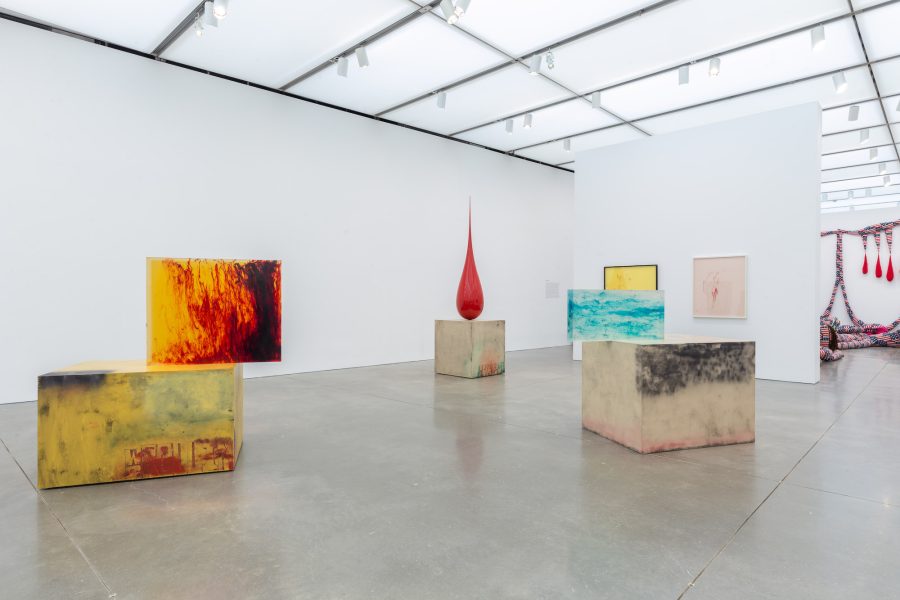
Installation view, Sterling Ruby, Institute of Contemporary Art/Boston, 2020. Courtesy Sterling Ruby Studio, Los Angeles. Photo by Mel Taing. © Sterling Ruby
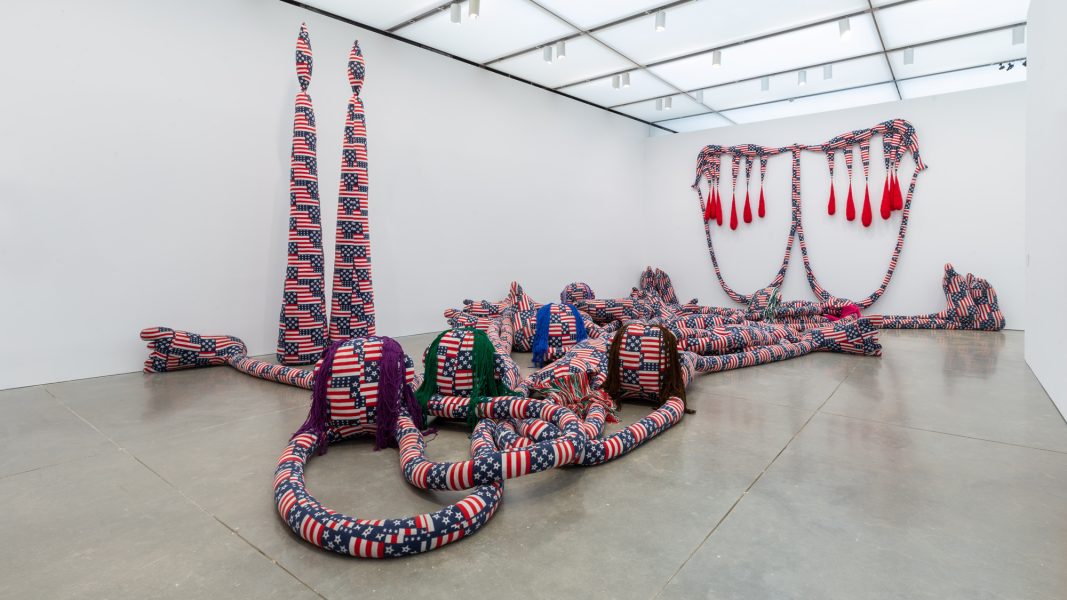
Installation view, Sterling Ruby, Institute of Contemporary Art/Boston, 2020. Courtesy Sterling Ruby Studio, Los Angeles. Photo by Mel Taing. © Sterling Ruby
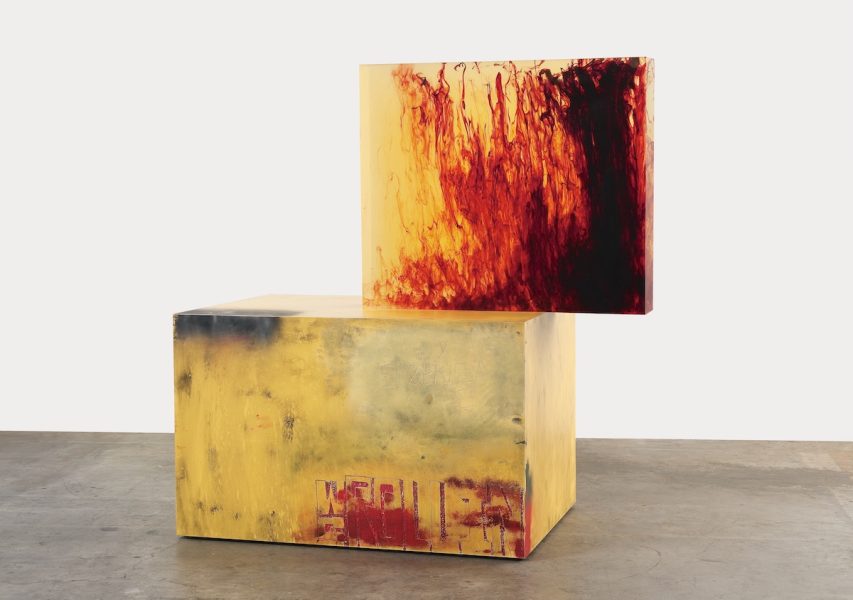
Sterling Ruby, ACTS/WS ROLLIN, 2011. Clear urethane block, dye, wood, spray paint, and formica, 60 1/2 x 62 1/2 x 34 inches (153.7 x 158.8 x 86.4 cm). Photo by Robert Wedemeyer. Courtesy Sterling Ruby Studio, Los Angeles. © Sterling Ruby Studio
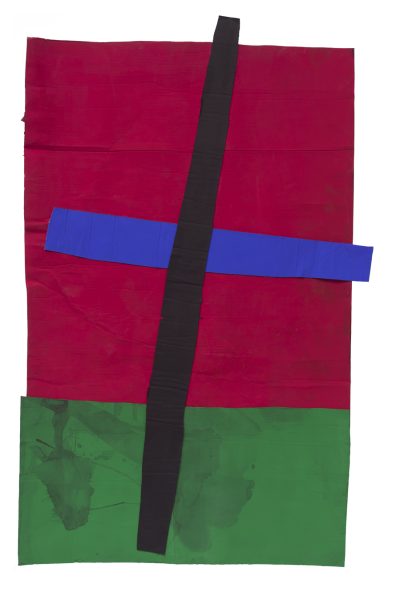
Sterling Ruby. ECLPSE (RBGBCROSS), 2015. Collage and paint on cardboard. 121 1/8 × 77 3/4 inches (307.7 × 197.5 cm. Photo by Robert Wedemeyer. Courtesy Sterling Ruby Studio, Los Angeles. © Sterling Ruby
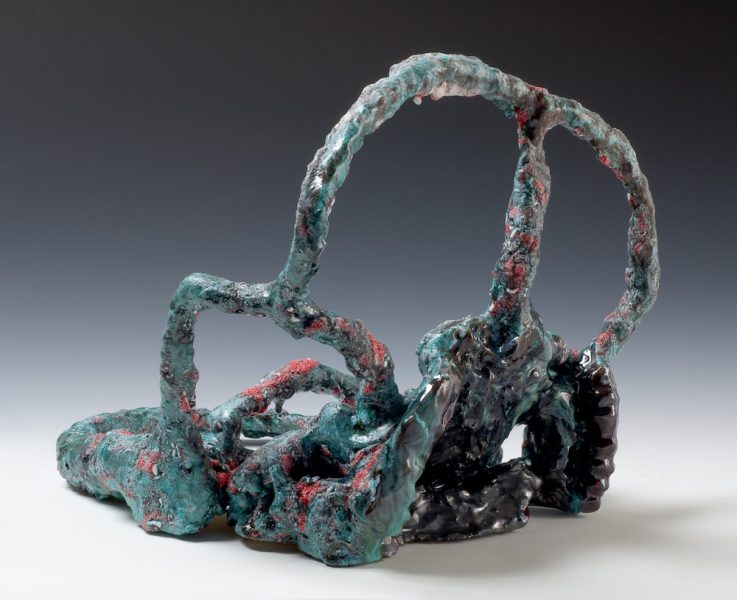
Sterling Ruby, Blue Angel, 2007. Ceramic, 16 1/2 × 18 × 19 1/2 inches (41.9 × 45.7 × 49.5 cm). Courtesy Sterling Ruby Studio, Los Angeles. Photo by Robert Wedemeyer. © Sterling Ruby

Sterling Ruby, SCXV3ST/BD, 2012. Fiberglass, wood, spray paint, and formica 120 × 34 × 34 inches (304.8 × 86.4 × 86.4 cm). Courtesy Sterling Ruby Studio, Los Angeles. Photo by Robert Wedemeyer. © Sterling Ruby

Sterling Ruby, FLAG/QUILT (6625), 2018. Bleached denim, treated fabric, and elastic 164 × 170 inches (416.6 × 431.8 cm). Courtesy Sterling Ruby Studio, Los Angeles. Photo by Robert Wedemeyer. © Sterling Ruby

Installation view, Sterling Ruby, Institute of Contemporary Art/Boston, 2020. Courtesy Sterling Ruby Studio, Los Angeles. Photo by Mel Taing. © Sterling Ruby

Installation view, Sterling Ruby, Institute of Contemporary Art/Boston, 2020. Courtesy Sterling Ruby Studio, Los Angeles. Photo by Mel Taing. © Sterling Ruby
ICA/Boston presents the first comprehensive museum survey for American artist Sterling Ruby.
The exhibition features more than 70 works that demonstrate the relationship between material transformation in Ruby’s practice and the rapid evolution of culture, institutions, and labor. Spanning more than two decades of the artist’s career, the exhibition looks to the origins and development of his practice, through mediums ranging from lesser-known drawings and sculptures to his renowned ceramics and paintings.
Since his earliest works, Ruby has investigated the role of the artist as an outsider. Critiquing the structures of modernism and traditional institutions, Ruby addresses the repressed underpinnings of U.S. culture and the coding of power and violence. Craft is central to his inquiry, as he explores California’s radical ceramics history and traditions of Amish quilt making, shaped by his upbringing in Pennsylvania Dutch country. The process of combining disparate elements is central to Ruby’s material reclamations, which serve as a form of autobiographical and cultural archeology. Organized loosely by chronology and medium, Sterling Ruby considers the artist’s explorations of these themes across the many materials and forms he has utilized throughout his practice.
Sterling Ruby is co-presented with Institute of Contemporary Art, Miami, and is accompanied by an illustrated scholarly catalogue edited by Alex Gartenfeld and Eva Respini, with a conversation between Ruby and Isabelle Graw. Published with DelMonico Prestel, the catalogue features essays that consider Ruby’s work amidst the contemporary art production and visual culture of the last 30 years.
Sterling Ruby (American/Dutch, b. 1972, Germany) is a leading contemporary artist whose work has been presented in solo exhibitions throughout the globe. Ruby received his B.F.A. in 2002 from the School of the Art Institute of Chicago, Illinois, and his M.F.A. in 2005 from the Art Center College of Design, Pasadena. He currently lives and works in Los Angeles.
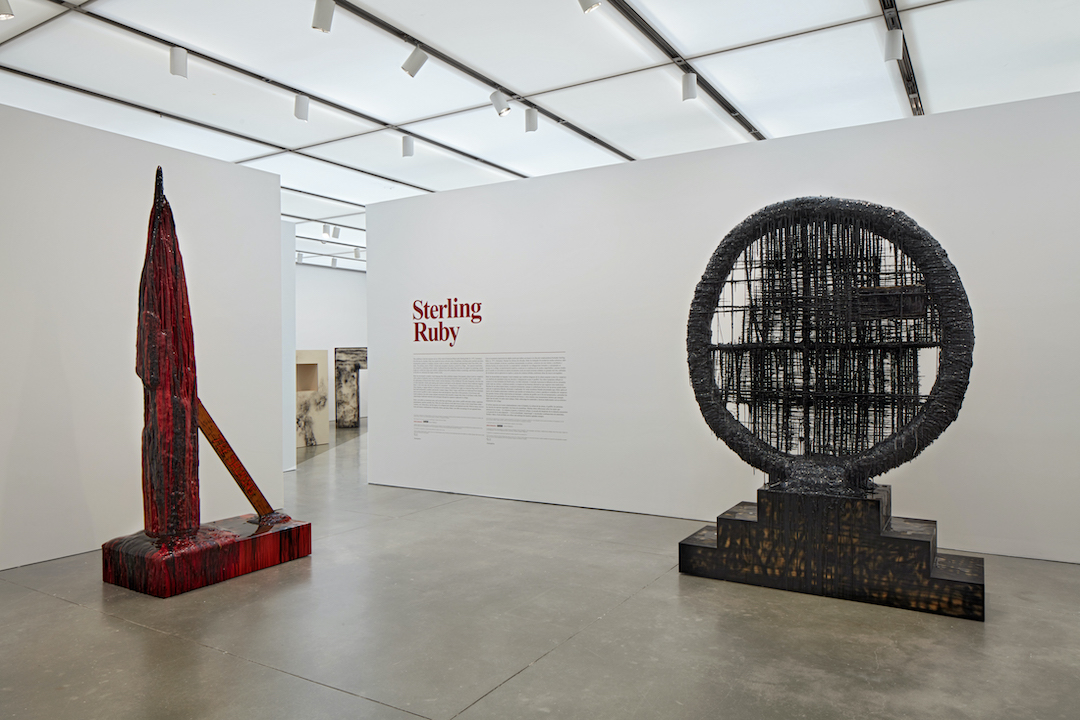
Installation view, Sterling Ruby, Institute of Contemporary Art/Boston, 2020. Courtesy Sterling Ruby Studio, Los Angeles. Photo by Charles Mayer. © Sterling Ruby
In 2006 Ruby began making monumental sculptures from poured urethane (a type of plastic) that aim to capture the gestural, expres-sionistic quality of his ceramics without limits to scale. These works take at least several months to complete because the artist pours small batches of liquid urethane over an armature in layers, working quickly before the urethanes solidifies. As a final step, color is applied as a kind of “tinting dye” with glossy coats of clear urethane. Often used for Hollywood prop-making, urethane is a recurring material in Ruby’s sculptural works. The time-sensitive quality of the material is key to the labor-intensive process and self-evident as an aesthetic gesture. The finish sculptures appear wet, as if they are still in formation. In 2007, after years of experimentation, Ruby settled on the recognizable form of his Monument Stalagmites (2005–13)—tall, upright accumulations supported by a wooden crutch on a low formica plinth.
Black Star/Prostitute’s Bolster, 2007
PVC pipe, urethane, wood, aluminum, and spray paint
La Colección Jumex, Mexico City
Monument Stalagmite/Bride Jr., 2011
PVC pipe, foam, urethane, wood, spray paint, and formica
Quilt/Body Snatchers, 2004
Collage on paper Monument
Stalagmite/The Shining, 2011
PVC pipe, foam, urethane, wood, spray paint, and formica
Ovitz Family Collection, Los Angeles

Installation view, Sterling Ruby, Institute of Contemporary Art/Boston, 2020. Courtesy Sterling Ruby Studio, Los Angeles. Photo by Charles Mayer. © Sterling Ruby
Throughout his career, Ruby has employed collage as a formal and conceptual mode of working, often experimenting with the medium to produce surprising results. He has described his approach to combining highly varied materials as an “illicit merger.” Ruby’s early collages, drawings, and prints provide a window into his artistic practice and preview the evolution of key themes in his work. Crystal Cryer (2001) suggests fraught invocations and instances of teardrops and stalagmite forms. Prison (2004) comprises one of Ruby’s first inquiries into the nature of confinement and institutions of power. Painted nails, pills, quilts, kilns, and imagery from cinema recur frequently throughout.
From left to right:
Top:
Girl in Kiln, 2004
Collage on paper
Bottom:
Transient Bed of John, 2003
Lambda print
Transient Bed of John (2003) contains some imagery essential to the artist’s understanding of Los Angeles: a tar pool contained with sandbags near the La Brea Tar Pits (an excavated fossil site from the Ice Age) by the Los Angeles County Museum of Art. Poked at by museumgoers during the day and often slept on by the homeless at night, these sandbags intrigued the artist. As layered, transient spaces, they reminded him of the very nature of the city, described by Ruby as a series of “activation sites of a variety of different curiosities… a strange mix of the prehistoric, the modern, the contemporary, the high and the low, the dirty, the polished.”
Kiln #1, 2005
Lambda print
Collection of Craig Robins and Jackie Soffer
STAR SKY, 2015
Collage, paint, and glue on paper
DRFTRS (6007), 2016
Collage, paint, and glue on paper
From left to right:
Pelican Bay Abstract, 2009
Collage and paint on paper
Nine collages, matted and framed
Ovitz Family Collection, Los Angeles
HRG Suite, 2005
Collage on paper
Nine collages, matted and framed
In these works the artist combines a variety of powerful motifs— from cinema, detention centers, Minimalist architecture, and space—to trace the influence of the grid as a paragon of modernist structure, regularity, order, and constraint. Dedicated to the artist H.R. Giger, HRG Suite (2005) features images of Giger’s ghoulish monster from the film Alien (1979), as well as references to the Scarecrow from The Wizard of Oz (1939), and the actress Linda Blair from The Exorcist (1973) among torsos of tattooed women, assailed political protestors, and a dense mob of US soldiers. These figures of trauma, transgression, and transformation mounted over vibrantly colored paper create a powerful visual presence that seems to protest against the pale, gridded matting holding them in strict quarters. Pelican Bay Abstract (2009), named after the infamous maximum security prison, contains colorful and frenzied abstraction within rigid, cell-like frames. The composition draws an evocative parallel to the prison’s sinister “correctional” confinement.
From left to right:
Pumpkin Head, 2008
Collage on paper
DRFTRS (4257), 2013
Collage, paint, and glue on paper
Head Trekkers 17, 2010
Collage on paper
The United States’ prison-industrial complex has long preoccupied Ruby, who from 2005–08 created a trio of exhibitions titled “SUPERMAX” after maximum-security prisons. These exhibitions featured sculptures, paintings, drawings, and collages installed densely to create a strong sense of claustrophobia. The orange paper used as the background for the collages—a nod to correctional facility uniforms—is combined with a variety of psychologically rich motifs, ranging from physical enhancement pills, to bloody horror movie stills from films like Pumpkinhead (1998), to idyllic landscapes contrasted with aerial and interior views of the notorious Pelican Bay State Prison. The artist equates this state of imprisonment—of being on permanent lockdown, in solitary confinement, and under sensory deprivation—to a dystopian view of contemporary society, politics, and violence. “This exists here and now, in America,” he says. “There is no redemption, only a state of detainment.”
From left to right:
DR (6503), 2017
Pen on paper
Snowball, 2001
Pencil on paper
Crystal Cryer, 2001
Pencil on paper
Prison, 2004
Collage and colored pencil on paper
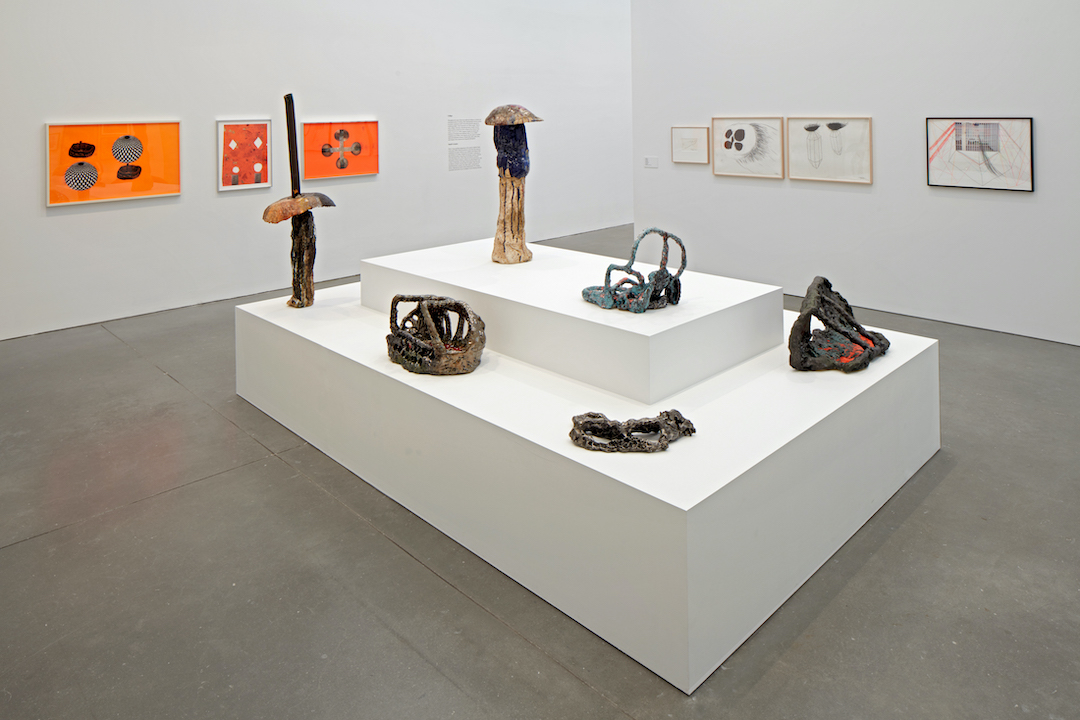
Installation view, Sterling Ruby, Institute of Contemporary Art/Boston, 2020. Courtesy Sterling Ruby Studio, Los Angeles. Photo by Charles Mayer. © Sterling Ruby
Ruby’s long-standing engagement with ceramic sculpture began in the early 2000s when he enrolled in a free-form clay class at a community art center while he was a student at the School of the Art Institute of Chicago. Intrigued by his mother’s collection of West German pottery, the notion of art therapy, and the California Clay Movement of the 1950s, Ruby has fostered a sustained fascination with the medium’s capacity for expressing gesture with a sense of immediacy. He brings various functional forms, such as ashtrays or basins, into the realm of sculpture. Ruby has also transformed these ceramics into other media, such as casting them in bronze, depicting the hand-worked characteristics of a medium associated with craft in one of sculpture’s most enduring materials.
| ASHTRAY 141, 2010 Ceramic |
|
| ACTRESS 2, 2010 Bronze with silver nitrate patina |
|
| TROOPER, 2017 Ceramic Private collection |
|
| Modern Brass/ Ketamine User, 2012 Ceramic Collection of Maurice Marciano |
|
| Hiker (4949), 2014 Bronze with silver nitrate patina |
|
| Drive-Thru Pewter Facial, 2010 Ceramic Collection of Thomas H. Lee and Ann Tenenbaum |
|
| Blue Angel, 2007 Ceramic |
|
| ANGLE OF DEPRESSION, 2017 Ceramic |

Installation view, Sterling Ruby, Institute of Contemporary Art/Boston, 2020. Courtesy Sterling Ruby Studio, Los Angeles. Photo by Charles Mayer. © Sterling Ruby
Ruby’s series of geometric solids, formica monoliths in different shapes and orientations that he often tags with spray paint or otherwise inscribes, reveal his approach to grappling with the historical legacy of Minimalism in sculpture. In Big Grid/DB Deth (2008), for example, the artist has defiled the white, geometric construction with black spray paint and etched inscriptions. ZEN RIPPER (2008) exhibits a similar approach.
From left to right (in photo):
Big Grid/DB Deth, 2008
Formica, spray paint, and wood
ZEN RIPPER, 2008
Formica, spray paint, and wood

Installation view, Sterling Ruby, Institute of Contemporary Art/Boston, 2020. Courtesy Sterling Ruby Studio, Los Angeles. Photo by Charles Mayer. © Sterling Ruby
Since 2005, Ruby has made color photographic prints (referred to as C-prints) that extend the formal strategies of collage into photography, allowing him to integrate ever more diverse references. Layered, rearranged, and digitally manipulated, these prints result in a dynamic collision of found and reworked images and motifs.
Cry 2005 (2005), a chaotic patchwork of images featuring bleached fabric, spray-painted plywood, and glazed ceramics, is scrawled over in bold, black graffiti that spells out “CRY.” While the poignant word suggests an anxious, raw, or vulnerable mode of expression, the method of inscription carries a rebellious and menacing quality, emphasized by the pair of eyes below it. The central image of what seems like an archeological site highlights the artist’s practice of digging through his studio and “cannibalizing” or reworking materials and motifs.
Cry 2005, 2005
Lambda print
Private collection
Death Cult (6150), 2016
Archival inkjet print
Death Cult (6148), 2016
Archival inkjet print

Installation view, Sterling Ruby, Institute of Contemporary Art/Boston, 2020. Courtesy Sterling Ruby Studio, Los Angeles. Photo by Charles Mayer. © Sterling Ruby
Following Ruby’s geometric solids, the works in a subsequent series, ACTS (Absolute Contempt for Total Serenity) (2006–18), capture liquid dyes in clear urethane blocks that balance atop scratched-up and spray-painted formica bases. The suspended pigments are fixed between liguid and solid states, disrupting the purity of the prism. The formica volumes embody Minimalist forms and colors, while Ruby’s aggressive gestures on the assembled configurations disrupt their uniformity.
In this room:
From left to right (in photo):
ACTS/WS ROLLIN, 2011
Clear urethane block, dye, wood, spray paint, and formica
Institute of Contemporary Art, Miami; Gift of The Hinson Family, by exchange
SCXV3ST/BD, 2012
Fiberglass, wood, spray paint, and formica
ACTS/ 187 DREAMER, 2009
Clear urethane block, dye, wood, spray paint, and formica
Collection of Andre Sakhai, New York
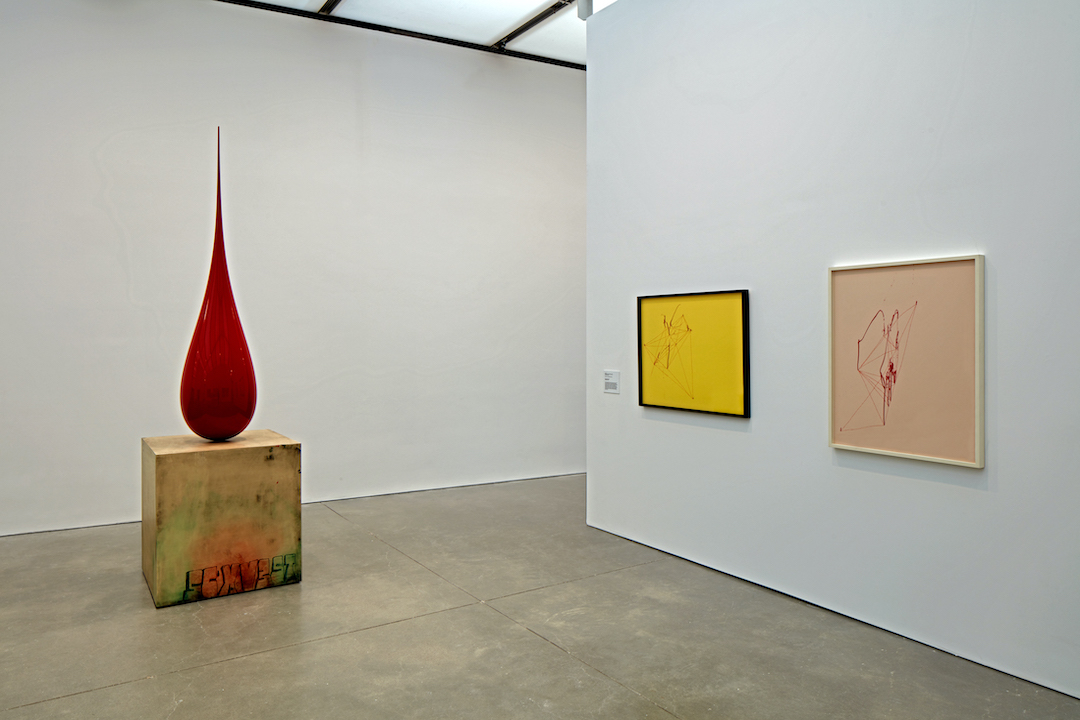
Installation view, Sterling Ruby, Institute of Contemporary Art/Boston, 2020. Courtesy Sterling Ruby Studio, Los Angeles. Photo by Charles Mayer. © Sterling Ruby
Ruby’s Mapping (2003–09) series features the signature linear mark-making technique of his early drawings and collages, though here he applies only nail polish on brightly colored paper. Nail polish persists as a material in Ruby’s collages for the gendered associations it calls forth. Each drawing comprises an esoteric map-like composition of rigid, interconnected lines disrupted by drops and smears of nail polish that resemble blood, lending ominous overtones to otherwise rudimentary, abstract works.
From left to right:
(Mapping) Jordache Nail Polish, 2005
Nail polish on paper
Collection of Andre Sakhai, New York
Mapping (Pink), 2005
Nail polish on paper

Installation view, Sterling Ruby, Institute of Contemporary Art/Boston, 2020. Courtesy Sterling Ruby Studio, Los Angeles. Photo by Charles Mayer. © Sterling Ruby
Alabaster is a mineral rock used for centuries for statuary, carvings, and other ornaments. The beautiful expanse of cast acrylic in Ruby’s Alabaster (2006–11) paintings recalls the suspended liquid dyes in his ACTS sculpture sries, which were made around the same time, while referring to the translucent quality of alabaster. These paintings balance an ethereal, yet heavy quality, like a moment frozen in time. They display a dynamic visual tension between fluidity and coagulation, defacement and decoration, mirroring Ruby’s sustained practice of adopting Minimalist forms while searching to liberate such forms from their inherent rigidity. “Everything I do holds a kind of gesture in it,” Ruby recalls. “For me, it’s a dramatic gesture. A truncated gesture. It’s like an expression that was at one point very fervent and then it just gets frozen, halted.”
From left to right:
Alabaster SR08-2, 2008
Cast acrylic
Alabaster SR10-16, 2010
Cast acrylic
Collection of Javier and Monica Mora
Alabaster SR11-58, 2011
Cast acrylic
Collection of Ray Ellen and Allan Yarkin, Miami

Installation view, Sterling Ruby, Institute of Contemporary Art/Boston, 2020. Courtesy Sterling Ruby Studio, Los Angeles. Photo by Mel Taing. © Sterling Ruby
At times satirical and at others melancholic, Ruby’s soft sculptures are large-scale cartoons made from stuffed textiles. Often immersive, the works invoke monuments in their size, although their soft textures seem to contradict their own potency. Influenced by Ruby’s childhood experience with Amish quilt-making in rural Pennsylvania, these works embody the artist’s attraction to craft and its connotations relating to gender and modernity. Ruby has used fabric with many motifs; the installation here includes works with a US flag pattern, suggesting. the artist’s critical views of patriotism and violence. These confrontational works can pack a grotesque punch: DOUBLE VAMPIRE 14 (2013) forms sneering, parted lips and fangs dripping with blood. DOUBLE CANDLE (6992) (2019) suggests domestic life and ritual, but also mourning. A new installation, FIGURES. PILE. (6991) (2019), depicts a heap of interconnected bodies tagged with the American flag, highlighting the innate connections and collisions among bodies during war and disaster.
Clockwise from right:
VAMPIRE 129, 2014
Fabric and fiberfill
QUILT (4858), 2014
Bleached and dyed canvas and elastic
DOUBLE CANDLE (6992), 2019
Fabric and fiberfill
FIGURES. PILE. (6991), 2019
Fabric, yarn, and fiberfill
DOUBLE VAMPIRE 14, 2013
Fabric and fiberfill
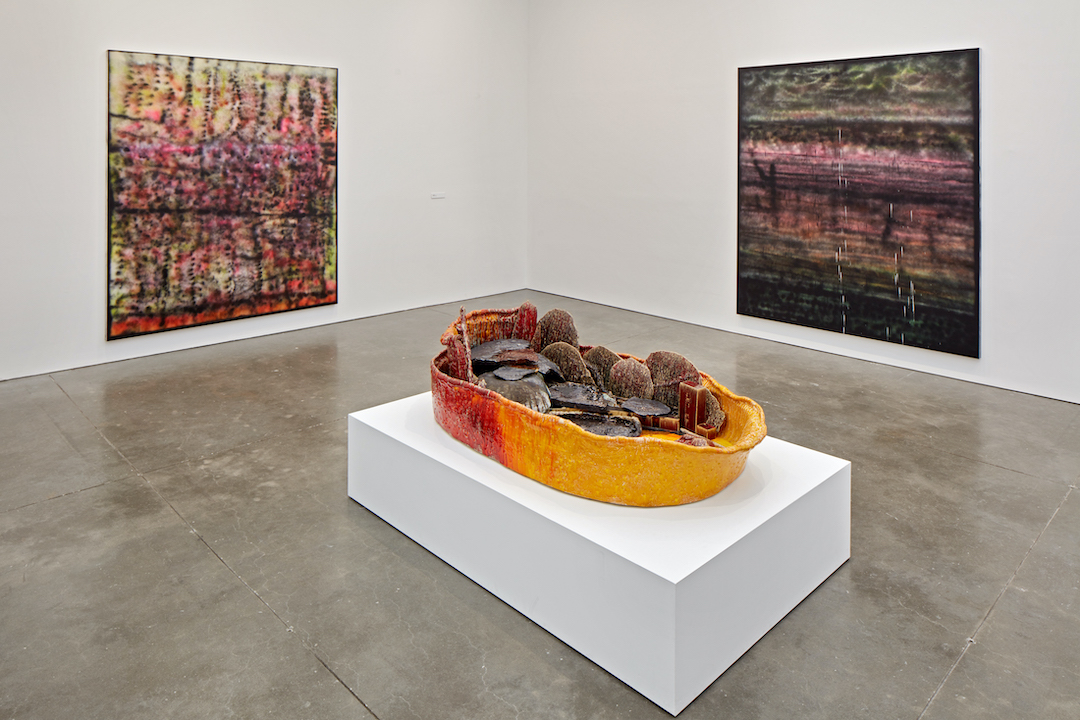
Installation view, Sterling Ruby, Institute of Contemporary Art/Boston, 2020. Courtesy Sterling Ruby Studio, Los Angeles. Photo by Charles Mayer. © Sterling Ruby
Around 2003 Ruby bagan implementing a variety of spray painting techniques in different mediums to create textured grounds for his colalges on paper or as a means of tagging and defiling the uniformity of his formica sculptures. In 2007 he made his first monumental spray paintings on canvas, a series called SP (2007–14). Each work is an atmospheric color field painting worked extensively by hand with an abstract lexicon of overlapping dots, drips, lines, and shapes. Introduced to graffiti at a young age, Ruby developed an interest in such forms of renegade expressivity thanks to his proximity to the Washington, DC punk scene and later the spray-painted gang insignia around Los Angeles. Utilizing a material often seen as transgressive or subcultural, Ruby’s use of spray paint explores a broad range of cultural, historical, and formal associations.
SP04, 2007
Spray paint on canvas
SP49, 2008
Spray paint on canvas
Private collection, New York
SP131, 2010
Spray paint on canvas
SP242, 2013
Spray paint on canvas
Whitney Museum of American Art, New York; Gift of Guy Starkman
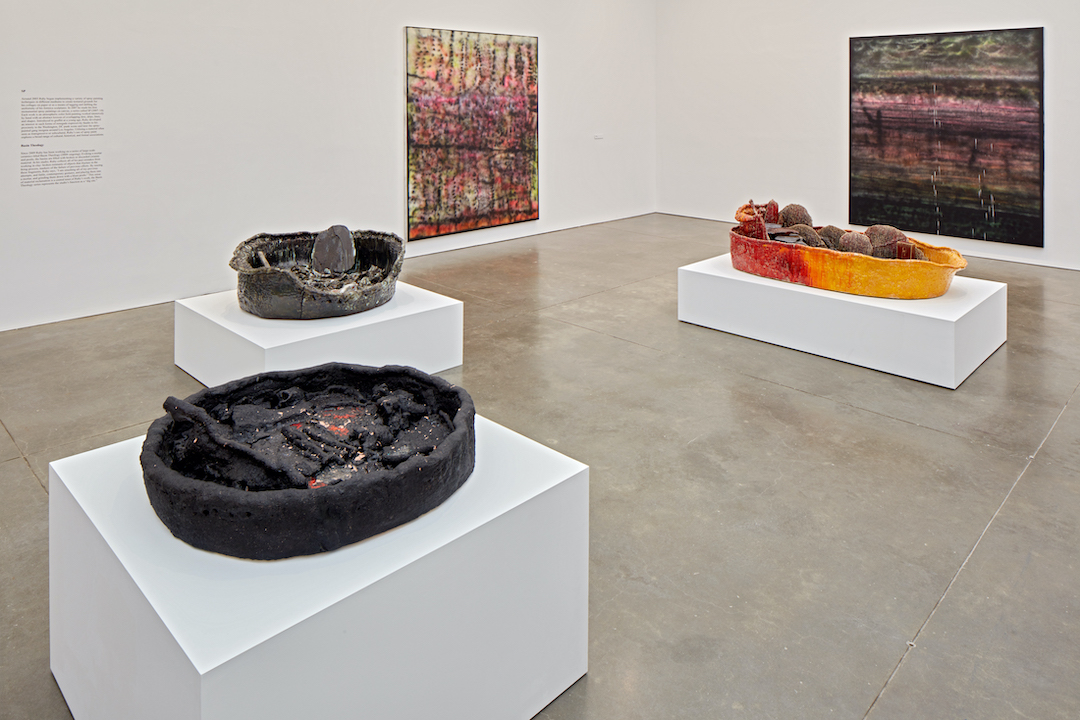
Installation view, Sterling Ruby, Institute of Contemporary Art/Boston, 2020. Courtesy Sterling Ruby Studio, Los Angeles. Photo by Charles Mayer. © Sterling Ruby
Since 2009 Ruby has been working on a series of large-scale ceramics titled Basin Theology (2009–ongoing). Evoking a mortar and pestle, the basins are filled with broken or discarded ceramic material. In his studio, Ruby collects all of his past mistakes from working in clay: broken remnants of objects that fracture in the firing process, markers of the failure of previous efforts. By reusing these fragments, Ruby says, “I am smashing all of my previous attempts, and futile, contemporary gestures, and placing them into a mortar, and grinding them down with a blunt pestle.” This sense of material reclamation is a central tenet of Ruby’s work; the Basin Theology series represents the studio’s function as a “dig site.”
From left to right (in photo):
Basin Theology/LA BREA 2, 2011
Ceramic
Ovitz Family Collection, Los Angeles
Basin Theology/CRYPTOCRYSTALLINE, 2016
Ceramic
Basin Theology/HELIOS BOAT, 2019
Ceramic
Collection of Charlotte and Herbert S. Wagner III, Boston

Installation view, Sterling Ruby, Institute of Contemporary Art/Boston, 2020. Courtesy Sterling Ruby Studio, Los Angeles. Photo by Charles Mayer. © Sterling Ruby
During a month-long stay at the Chinati Foundation in Marfa, Texas, in 2010, near the United States-Mexico border, Ruby began a series of welded and cut steel sculptures he refers to as MS (metal sculptures) (2010–11). Made from widely used industrial materials such as plate metal and rebar, these works range in scale from tabletop assemblages to large, freestanding sculptures. Many of the MS works are pockmarked with crude welds that achieve a makeshift aesthetic. Ruby’s TABLE 4 (2015) is similarly marked, though the aberrations in form also point to decades of industrial use. In 2015 Ruby moved into a studio just outside of Los Angeles and salvaged the welding tables left behind from the building’s previous life as an industrial warehouse. By covering these steel work tables with jutting scrap metal and tumorigenic masses of solder during the production of his own welding projects, Ruby memorializes the industrial labor that once took place on their surfaces. The table becomes a hulking, organic being—a haunting archaeological remnant from some unnamed human history.
FLAG/QUILT (6625), 2018
Bleached denim, treated fabric, and elastic
See soft sculpture
Opposite:
TABLE 4, 2015
Steel
| MS06-2872, 2010 Steel |
|
| MS07-2873, 2010 Steel |
|
| MS13-2879, 2010 Steel |
|
| MS01-2867, 2010 Steel |

MS16-2883, 2010
Steel

Installation view, Sterling Ruby, Institute of Contemporary Art/Boston, 2020. Courtesy Sterling Ruby Studio, Los Angeles. Photo by Charles Mayer. © Sterling Ruby
Foundational to Ruby’s practice, collage infuses all of his artistic output: from his early works on paper to his DRFTRS (2012–ongoing) series, collage-hybrids of images set against expressionsitic landscapes; from his WIDW (2016–ongoing) paintings, layered with cut cardboard and fabric swaths, to his bleached BC (2011–15) canvases, pasted over with colorful fabric. The BC series evolved out of Ruby’s studied consideration of quilting and his technique of reusing discarded materials leftover from works in other mediums. For these pieces, he treats each fabric panel with poured or splattered bleach before collaging them with fabric scraps, found clothing, and other textiles, such as moving blankets or strips of colorful fabric.
From left to right:
BC (5289), 2014
Fabric, glue, and bleached canvas on panel
BC (3950), 2012
Fabric, paint, glue, and bleached canvas on panel
Opposite:
Physicalism/The Recombine 1-6, 2006
Lambda prints
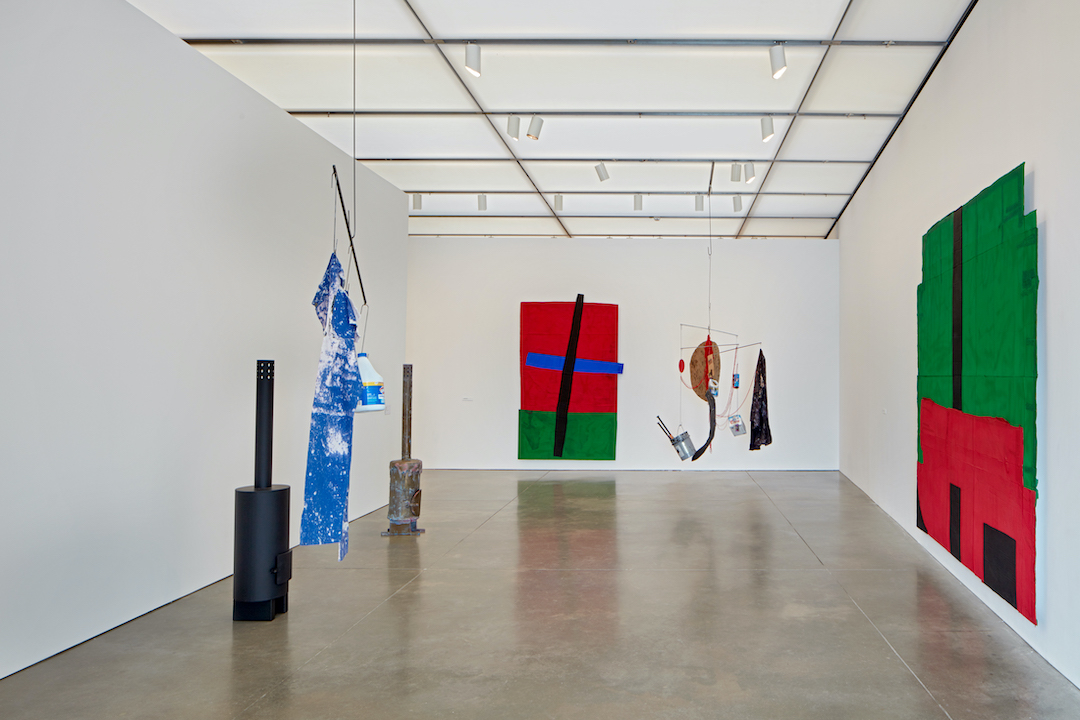
Installation view, Sterling Ruby, Institute of Contemporary Art/Boston, 2020. Courtesy Sterling Ruby Studio, Los Angeles. Photo by Charles Mayer. © Sterling Ruby
During a trip to China in 2011, Ruby observed workers in a foundry using leftover materials to construct makeshift furnaces. Configured during harsh winters, these roughly welded structures would then be disassembled in the next season. The stoves reminded Ruby of tending to his family’s wood-burning stove as a child. In 2012 he began to create his own as sculpture. Whether in textured, patinated bronze or sleekly polished steel, Ruby’s STOVES (2012–14) embody an industrial look. Their forms suggest that they could provide heat and create a warm, communal space, yet few function or burn wood. Most rest dormant, appearing, in the artist’s words, “almost like relics.” The STOVES also reference Ruby’s ceramics practice, although he does not use them to fire the forms for which he is so well known. Instead, they breed tension between manufacturing and artistic production, while highlighting reuse and the transformational qualities that are foundational to his work.
From left to right:
STOVE 4, 2013
Painted stainless steel
STOVE 3, 2012
Bronze and paint
Collection of Isabel and Ricardo Ernst

Installation view, Sterling Ruby, Institute of Contemporary Art/Boston, 2020. Courtesy Sterling Ruby Studio, Los Angeles. Photo by Charles Mayer. © Sterling Ruby
In Ruby’s studio, throwaway materials are often incorporated into new works, carrying forward fragments of previous pieces into newer bodies. Here, Ruby has repurposed pieces of cardboard from his studio for ECLPSE (2014–15), a series of large-scale abstract collages. The cardboard has been cut into shapes that resemble suns, moons, or other landscape elements, painted in primary colors, and arrayed in various configurations. The richly painted pieces of cut cardboard and Ruby’s pattern of reuse recur in SCALES (2013–18) his series of self-referential mobiles. Monumental three-dimensional hanging collages, these works often juxtapose cardboard shapes with other recognizable elements from Ruby’s creative output. These materials introduce different narrative elements and function as a compendium of Ruby’s studio practice and the studio itself.
SCALE (4586), 2013
Steel, paint, cardboard, yarn, and mixed media
SCALE (5415) S.R. CLOR., 2015
Steel and mixed media
ECLPSE (GRB), 2015
Collage and paint on cardboard
ECLIPSE (RBGBCROSS), 2015
Collage and paint on cardboard
From left to right:
ENGULFED COROLLA, 2017
Acrylic, oil, elastic, and cardboard on canvas
Collection of the Witkoff Family, Miami
HOT FLAT LIGHT, 2017
Acrylic, oil, elastic, and cardboard on canvas
Private collection
Sterling Ruby is organized by Eva Respini, Barbara Lee Chief Curator, ICA/Boston, and Alex Gartenfeld, Artistic Director, ICA, Miami, with Jeffrey De Blois, Assistant Curator and Publications Manager, ICA/Boston.
Sterling Ruby is on view at ICA, Miami November 7, 2019 – February 2, 2020.
Major support for Sterling Ruby is provided by Sprüth Magers, Gagosian, and Xavier Hufkens.

Additional support for the Boston presentation is generously provided by Stephanie Formica Connaughton and John Connaughton, Jean-François and Nathalie Ducrest, Bridgitt and Bruce Evans, James and Audrey Foster, Ted Pappendick and Erica Gervais Pappendick, David and Leslie Puth, and Charlotte and Herbert S. Wagner III.